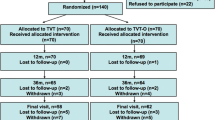Abstract
Introduction and hypothesis
There is currently no data on the safety and efficacy of the Advantage sling despite its widespread use.
Methods
We compared the efficiency and safety outcome data of 556 tension-free vaginal tape (TVT) and 108 Advantage slings after assessing for potential confounding factors.
Results
The two groups proved comparable. Bladder injury rates were 4.6% for the Advantage group and 2.9% for the TVT group (p = 0.36). Subjective stress incontinence cure were 83.3% and 85.3%, respectively (p = 0.66). Incidences of de novo urgency, urge incontinence, and voiding difficulties were 22.2% vs 14.7% (p = 0.06), 9.3% vs 7.4% (p = 0.55), and 11.1% vs 6.7% (p = 0.11), respectively.
Conclusions
No major differences between the two slings were observed apart from a non-significant trend towards more de novo urgency and voiding difficulty symptoms with the Advantage group. It may be possible that due to its different biomechanical properties, the Advantage slings should be left looser.
Similar content being viewed by others
References
Ulmsten U (2001) An introduction to tension-free vaginal tape (TVT)—a new surgical procedure for treatment of female urinary incontinence. Int Urogynecol J Pelvic Floor Dysfunc 12:3–4
Shumaker SA, Wyman JF, Uebersax JS, McClish D, Fantl JA (1994) Health-related quality of life measures for women with urinary incontinence: the Incontinence Impact Questionnaire and the Urogenital Distress Inventory. Continence Program in Women (CPW) Research Group. Qual Life Res 3:291–306
Barber MD, Walters MD, Bump RC (2005) Short forms of two condition-specific quality-of-life questionnaires for women with pelvic floor disorders (PFDI-20 and PFIQ-7). Am J Obstet Gynecol 193:103–113
Ward K, Hilton P, UK and Ireland TVT Trial Group (2002) Prospective multicentre randomised trial of tension-free vaginal tape and colposuspension as primary treatment for stress incontinence. BMJ 325(7355):67
Ward KL, Hilton P, UK and Ireland TVT Trial Group (2008) Tension-free vaginal tape versus colposuspension for primary urodynamic stress incontinence: 5-year follow up. BJOG 115(2):226–233
Lim YN, Muller R, Corstiaans A, Dietz HP, Barry C, Rane A (2005) Suburethral slingplasty evaluation study in North Queensland, Australia: the SUSPEND trial. Aust N Z J Obstet Gynaecol 45(1):52–59
Rechberger T, Rzezniczuk K, Skorupski P et al (2003) A randomized comparison between monofilament and multifilament tapes for stress incontinence surgery. Int Urogynecol J Pelvic Floor Dysfunc 14(6):432–436
Meschia M, Pifarotti P, Bernasconi F et al (2006) Tension-free vaginal tape (TVT) and intravaginal slingplasty (IVS) for stress urinary incontinence: a multicentre randomised trial. Am J Obstet Gynecol 195(5):1338–1342
Balakrishnan S, Lim YN, Barry C, Corstiaans A, Kannan K, Rane A (2007) Sling distress: a subanalysis of the IVS tapes from the SUSPEND trial. Aust N Z J Obstet Gynaecol 47(6):496–498
Bazi TM, Hamade RF, Hussein IAH, Nader KA, Jurjus A (2007) Polypropyelene midurethral tapes do not have similar biologic and biomechanical performance in the rat. Eur Urol 51:1364–1375
Moalli PA, Papas N, Menefee S, Albo M, Meyn L, Abramovich SD (2008) Tensile properties of five commonly used mid-urethral slings relative to the TVT. Int Urogynecol J Pelvic Floor Dysfunc 19:655–663
Stav K, Dwyer PL, Rosamilia A, Schierlitz L, Lim YN, Lee J (2009) Risk factors for treatment failure of midurethral sling procedures for women with urinary stress incontinence. Int Urogynecol J Pelvic Floor Dysfunct 21:149–155
Conflicts of interest
Dr. Y.N. Lim is an ad hoc preceptor for Johnson & Johnson, and Dr. A. Rosamilia is an ad hoc preceptor for American Medical Systems.
Author information
Authors and Affiliations
Corresponding author
Appendix
Appendix
Rights and permissions
About this article
Cite this article
Lim, Y.N., Dwyer, P., Muller, R. et al. Do the Advantage slings work as well as the tension-free vaginal tapes?. Int Urogynecol J 21, 1157–1162 (2010). https://doi.org/10.1007/s00192-010-1157-6
Received:
Accepted:
Published:
Issue Date:
DOI: https://doi.org/10.1007/s00192-010-1157-6




